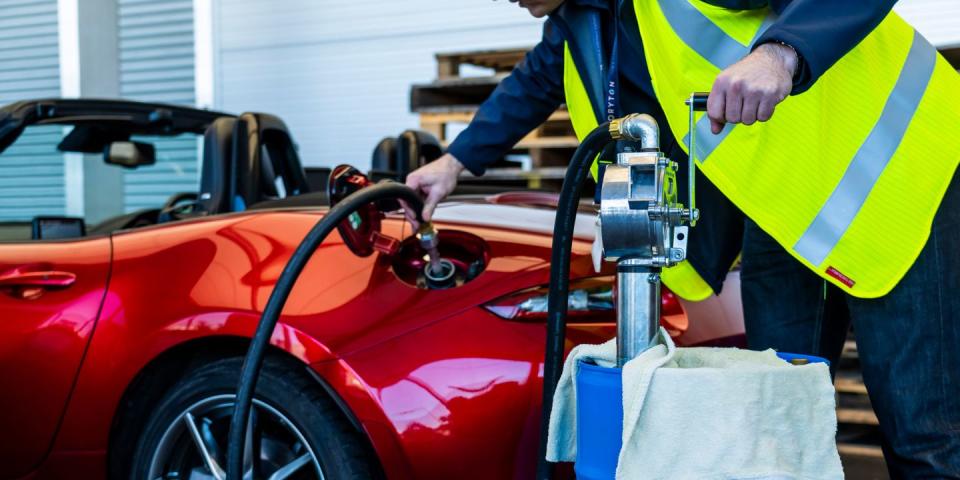Fossil-Free Fuels Power Mazda’s 1000-Mile Roadtrip

Mazda put an agricultural-waste based fuel to the test on a 1000-mile trip in the United Kingdom.
The test showed that this Coryton-sourced fuel would work in an unmodified Mazda MX-5 without a hitch.
After the test, Mazda reported the MX-5 Miata averaged 45.6 mpg during street driving.
If regulations are to be believed, and the flood of electric vehicles heading to showrooms is a signal, then the days of gasoline stations on every corner might go the way of the dodo. This is terrible news for folks who want to hold onto their internal-combustion engines. For fans of classics, modern classics, or vintage racing, this transition into electrification could cause a domino effect that takes gasoline with it.
But don’t worry—there might be a solution. Engineers at Mazda put non-fossil-based fuels to the test on a 1000-mile trip with an MX-5 Miata.
For the two-seat roadster, it wasn’t entirely a leisurely vacation tour. Mazda says this unmodified MX-5 completed laps at Anglesey Circuit in Wales, Oulton Park in England, Knockhill in Scotland, and Kirkistown in Northern Ireland. This trip spanned a week, and the hot laps didn’t factor into overall observed fuel economy. This wasn’t just for the love of driving: Mazda was actually testing a sustainable fuel from a company called Coryton.
Mazda says Coryton has a process that converts agricultural waste into a gasoline substitute. The company apparently uses straw and waste from other crops to create hydrocarbons that can then be used to feed an internal-combustion engine. This fuel also didn’t penalize the MX-5, and Mazda reports the 2.0-liter naturally aspirated four-cylinder pushed the Miata along at a 45.6 mpg average during the road test—obviously separate from the track testing.
This isn’t the first we’ve heard of synthetic fuels. Porsche has tested synthetic fuels in racing applications, and Formula 1 is marching toward them as well. Top-level motorsports is pivoting toward these fuels to reduce carbon emissions and to nudge fossil-free fuels into lower ranks of motorsport and, eventually, into the collector car hobby.
This all hinges on a few dominos tipping. If gasoline becomes harder to find because of mass EV adoption, it would make sense for gasoline substitutes to gain a foothold in motorsport and internal-combustion-centric hobbies. Though, it’s hard to see mass adoption of these fuels until traditional gasoline becomes harder to source.
Clearly, there are unanswered questions: How much does the fuel cost? Will this fuel be available to consumers anytime soon? Still, this journey shows that an unmodified Mazda MX-5 can use synthetic fuel, and that’s promising. The MX-5 handled track and road duty using Coryton fuels and, apparently, didn’t see a major penalty. Ultimately, this is great news for internal-combustion devotees.
Do you think synthetic fuels will be a viable solution for classic car collectors in the future? Tell us your thoughts below.

 Yahoo Autos
Yahoo Autos 